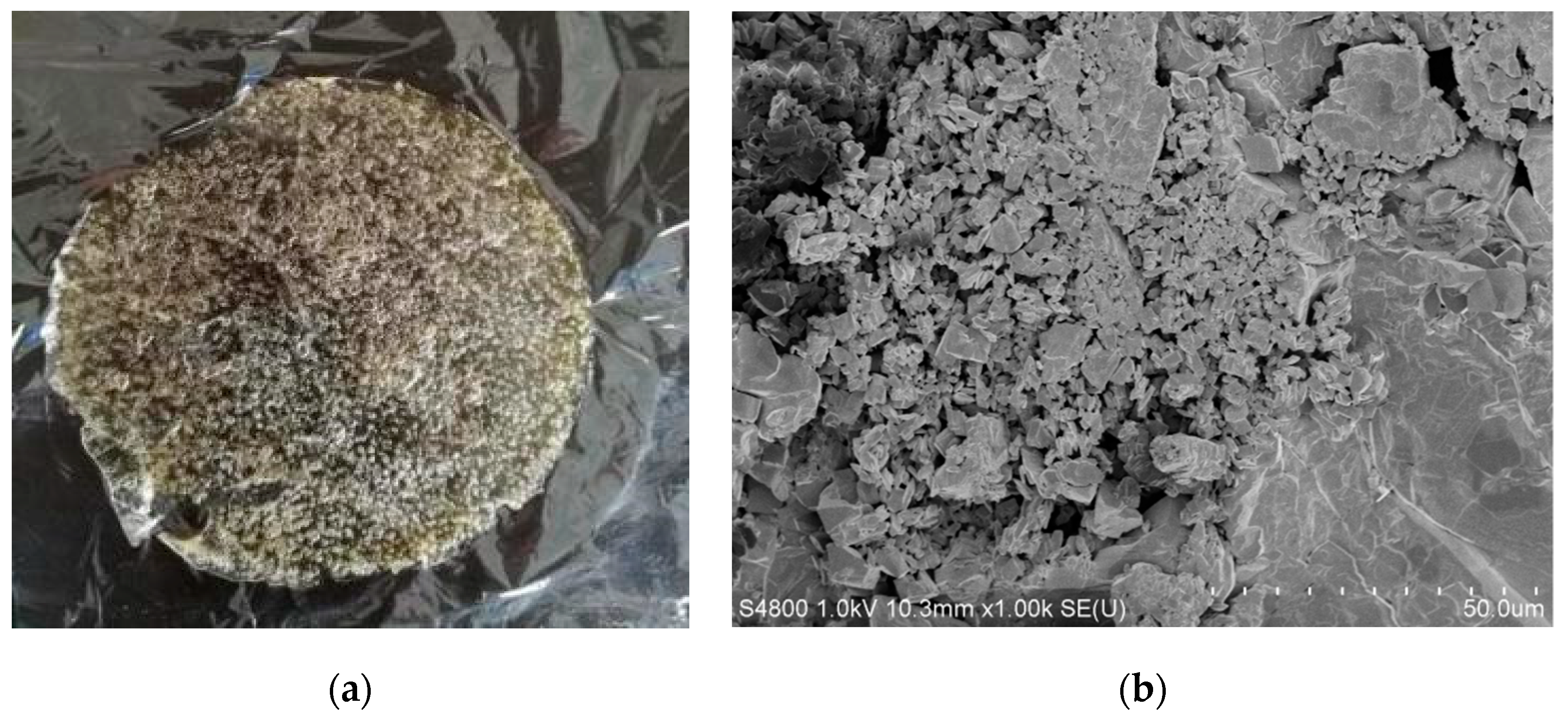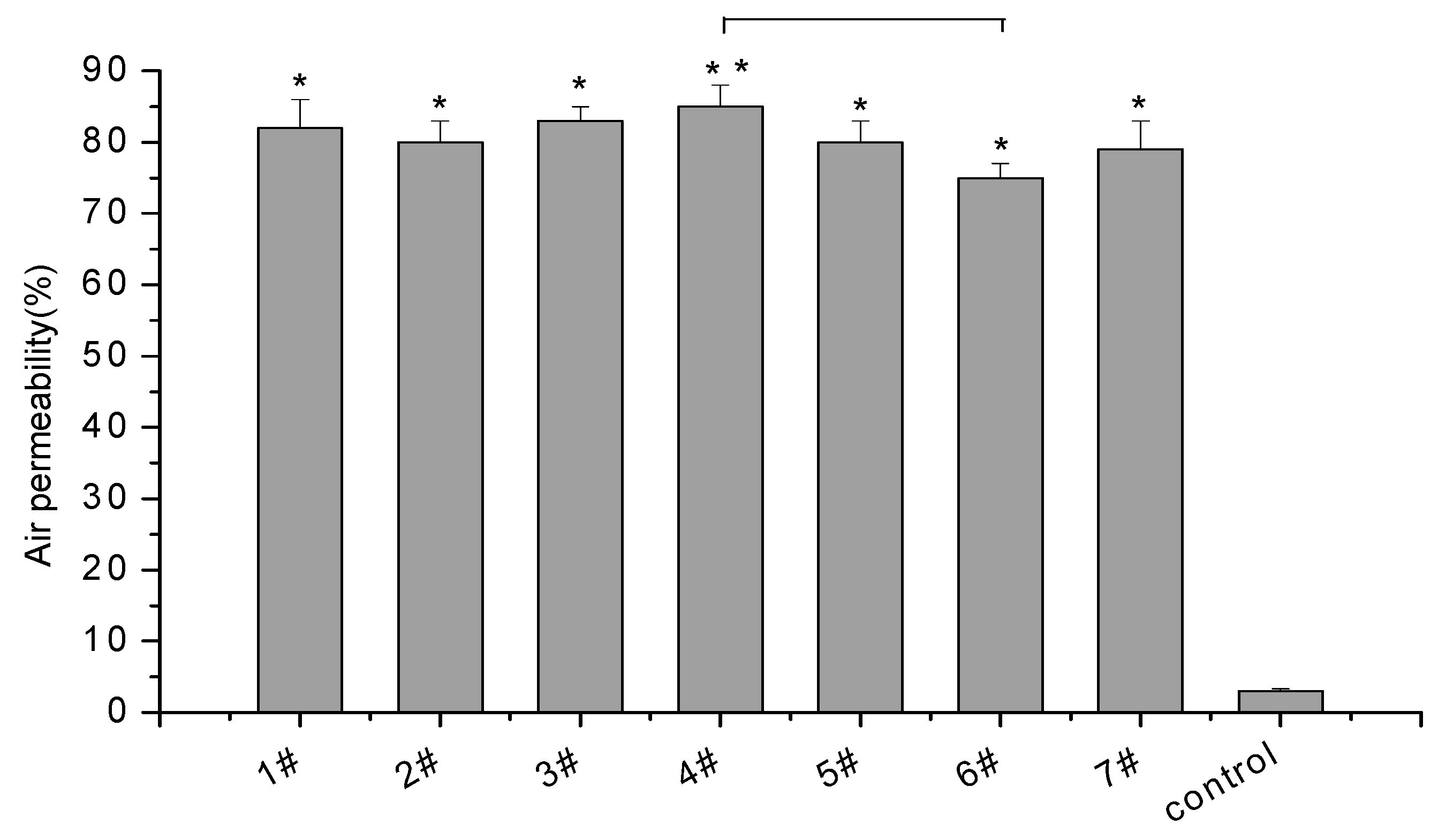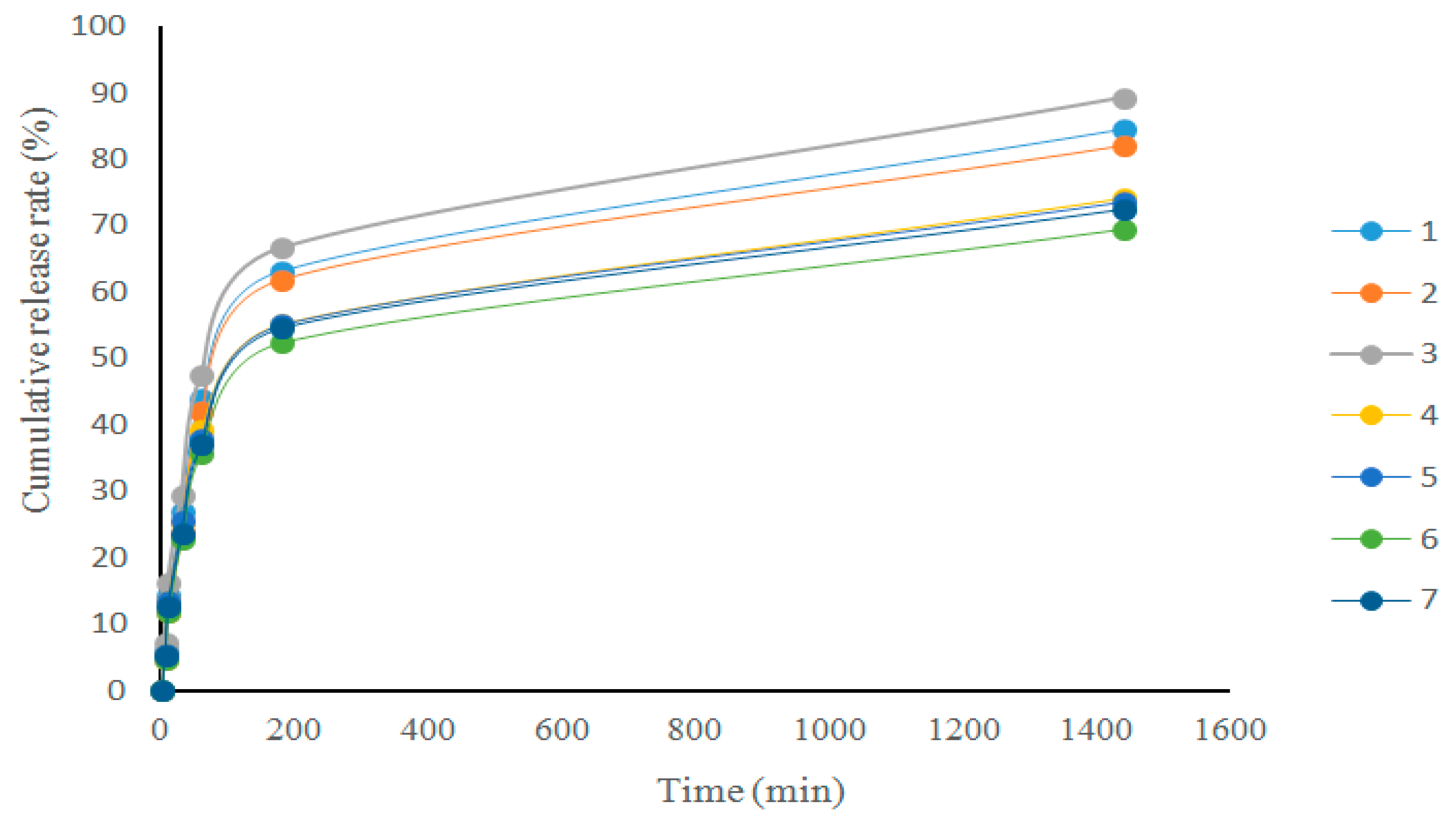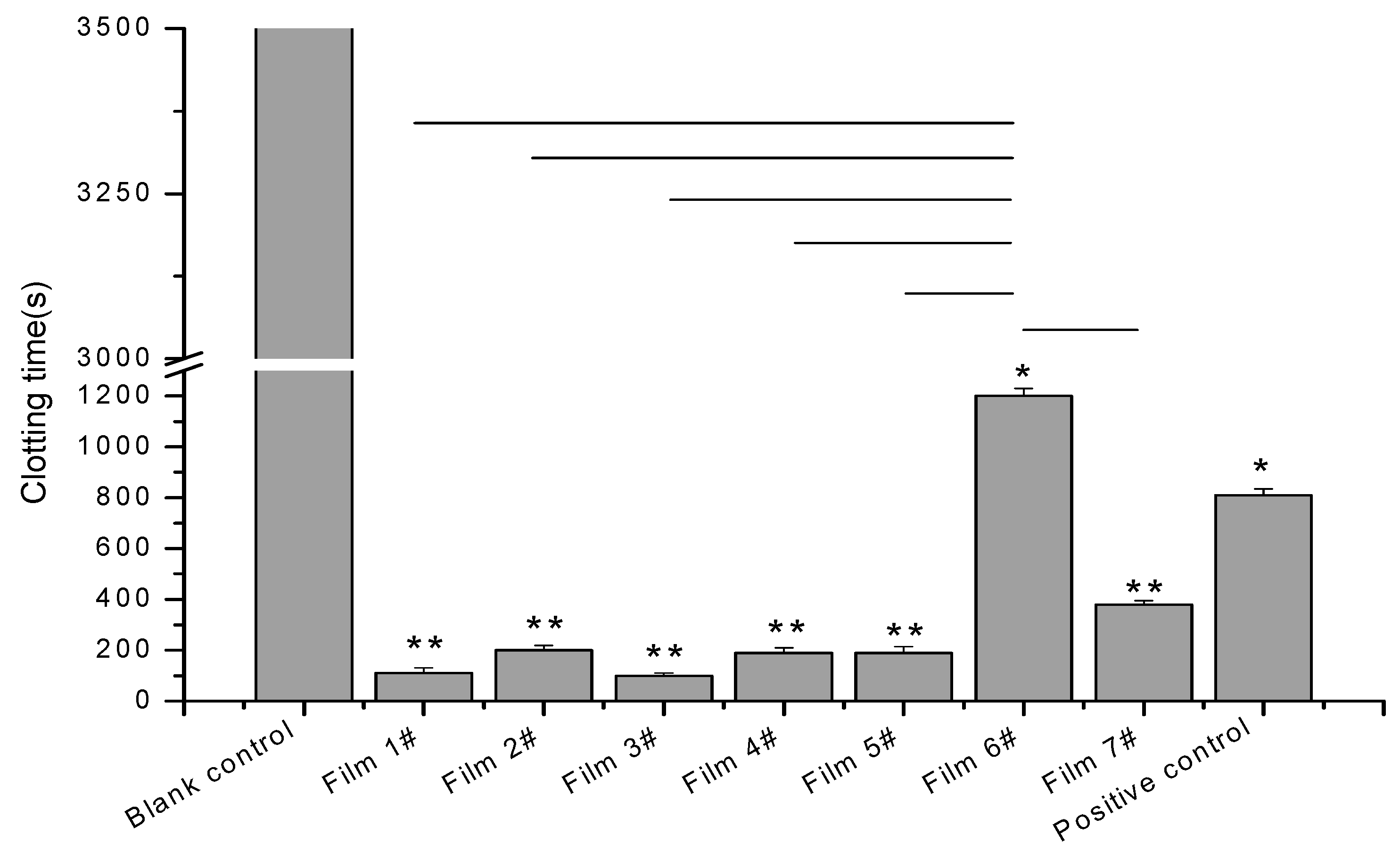Preparation and Properties of Carboxymethyl Chitosan/Alginate/Tranexamic Acid Composite Films
Abstract
:1. Introduction
2. Materials and Methods
2.1. Materials
2.2. Fabrication of the Composite Films
2.3. Appearance Observation
2.4. Measurement of Fourier Transform Infrared (FTIR)
2.5. Determination of Water Absorption Rate
2.6. Determination of Air Permeability
2.7. Determination of Cumulative Release Percent
2.8. In Vitro Clotting Time
3. Results and Discussion
3.1. Morphological Observation
3.2. Water Absorption
3.3. Air Permeability
3.4. FTIR Analysis
3.5. Cumulative Release Properties
3.6. Procoagulant Properties
4. Conclusions
Author Contributions
Funding
Acknowledgments
Conflicts of Interest
References
- Xu, C.; Xu, F.; Wang, B.; Lu, T.J. Electrospinning of poly(ethylene-co-vinylalcohol) nanofibres encapsulated with Ag nanoparticles for skin wound healing. J. Nanomater. 2011, 2011, 201834. [Google Scholar] [CrossRef]
- Al-Qattan, M.M.; Abd-Elwahed, M.M.; Hawary, K.; Arafah, M.M.; Shier, M.K. Myofibroblast expression in skin wounds is enhanced by collagen III suppression. BioMed Res. Int. 2015, 2015, 958695. [Google Scholar] [CrossRef] [PubMed]
- Jin, G.; Li, J.; Li, K. Photosensitive semiconducting polymer-incorporated nanofibers for promoting the regeneration of skin wound. Mater. Sci. Eng. C 2017, 70, 1176–1181. [Google Scholar] [CrossRef] [PubMed]
- Pogorielov, M.V.; Sikora, V.Z. Chitosan as a hemostatic agent: Current state. Eur. J. Med. Ser. B 2015, 2, 24–33. [Google Scholar] [CrossRef]
- Sun, X.; Tang, Z.H.; Pan, M.; Wang, Z.C.; Yang, H.Q.; Liu, H.Q. Chitosan/kaolin composite porous microspheres with high hemostatic efficacy. Carbohydr. Polym. 2017, 177, 135–143. [Google Scholar] [CrossRef] [PubMed]
- Yan, X.T.; Tong, Z.R.; Chen, Y.; Mo, Y.H.; Feng, H.Y.; Li, P.; Qu, X.S.; Jin, S.H. Bioresponsive materials for drug delivery based on carboxymethyl chitosan/poly(γ-glutamic acid) composite microparticles. Mar. Drugs 2017, 15, 127. [Google Scholar] [CrossRef] [PubMed]
- Liu, L.; Lv, Q.; Zhang, Q.Y.; Zhu, H.; Liu, W.; Deng, G.R.; Wu, Y.Q.; Shi, C.F.; Li, H.; Li, L.Z. Preparation of carboxymethyl chitosan microspheres and their application in hemostasis. Disaster Med. Public Health Prep. 2017, 11, 660–667. [Google Scholar] [CrossRef]
- Xie, W.; Li, Z.; Yang, M.; Yang, X. Preparation of carboxymethyl chitosan microspheres and the adsorption of heavy metal cadmium. Int. Conf. Innov. Mater. Sci. Tech. 2016, 139, 305–313. [Google Scholar]
- Pang, H.T.; Chen, X.G.; Ji, Q.X.; Zhong, D.Y. Preparation and function of composite asymmetric chitosan/CM-chitosan membrane. J. Mater. Sci. Mater. Med. 2008, 19, 1413–1417. [Google Scholar] [CrossRef] [PubMed]
- Horibe, S.; Tanahashi, T.; Kawauchi, S.; Mizuno, S.; Rikitake, Y. Preventative effects of sodium alginate on indomethacin-induced small-intestinal injury in mice. Int. J. Med. Sci. 2016, 13, 653–663. [Google Scholar] [CrossRef]
- Shi, X.Y.; Fang, Q.; Ding, M.; Wu, J.; Ye, F.; Lv, Z.B.; Jin, J. Microspheres of carboxymethyl chitosan, sodium alginate and collagen for a novel hemostatic in vitro study. J. Biomater. Appl. 2016, 30, 1092–1102. [Google Scholar] [CrossRef]
- Zhong, H.Q.; Ye, W.J.; Li, X.Y.; Wang, X.Y.; Sun, R.C. Polyelectrolyte sponge reinforced with organic rectorite and silver nanoparticles. Curr. Nanosci. 2013, 9, 742–746. [Google Scholar] [CrossRef]
- Montroy, J.; Hutton, B.; Moodley, P.; Fergusson, N.A.; Cheng, W.; Tinmouth, A.; Lavallée, L.T.; Fergusson, D.A.; Breau, R.H. The efficacy and safety of topical tranexamic acid: A systematic review and meta-analysis. Trans. Med. Rev. 2018, 32, 165–178. [Google Scholar] [CrossRef]
- Sard, S.; Errassifi, F.; Marsan, O.; Geffre, A.; Trumel, C.; Drouet, C. Adsorption of tranexamic acid on hydroxyapatite: Toward the development of biomaterials with local hemostatic activity. Mater. Sci. Eng. C 2016, 66, 1–7. [Google Scholar] [CrossRef] [PubMed]
- Zareh, M.M.; Wassel, A.A.; Abd Alkarem, Y.M. Electrochemical sensors for determination of tranexamic acid in pure form and pharmaceutical preparations. Int. J. Pharm. Sci. Res. 2016, 1, 5–12. [Google Scholar]
- Cheng, F.; Liu, C.Y.; Li, H.B.; Wei, X.J.; Yan, T.S.; Wang, Y.F.; Song, Y.J.; He, J.M.; Huang, Y.D. Carbon nanotube-modified oxidized regenerated cellulose gauzes for hemostatic applications. Carbohydr. Polym. 2018, 183, 246–253. [Google Scholar] [CrossRef]
- Balakrishnan, B.; Soman, D.; Payanam, U.; Laurent, A.; Labarre, D.; Jayakrishnan, A. A novel injectable tissue adhesive based on oxidized dextran and chitosan. Acta Biomater. 2017, 53, 343–354. [Google Scholar] [CrossRef]
- Luo, P.F.; Nie, M.; Wen, H.G.; Xu, W.Y.; Fan, L.H.; Cao, Q.H. Preparation and characterization of carboxymethyl chitosan sulfate/oxidized konjac glucomannan hydrogels. Int. J. Biol. Macromol. 2018, 113, 1024–1031. [Google Scholar] [CrossRef] [PubMed]
- Wang, C.; Luo, W.F.; Li, P.W.; Li, S.D.; Yang, Z.M.; Hui, Z.; Liu, Y.Y.; Ao, N.J. Preparation and evaluation of chitosan/alginate porous microspheres/Bletilla striata polysaccharide composite hemostatic sponges. Carbohydr. Polym. 2017, 174, 432–442. [Google Scholar] [CrossRef] [PubMed]
- Murphy, R.W.; Farkas, B.E.; Jones, O.G. Effect of crosslinking on the physical and chemical properties of β-lactoglobulin (Blg) microgels. J. Colloid Interface Sci. 2017, 505, 736–744. [Google Scholar] [CrossRef] [PubMed]
- Hui, L.; Gao, C. Preparation and properties of ionically cross-linked chitosan nanoparticles. Polym. Adv. Technol. 2010, 20, 613–619. [Google Scholar]
- Wang, J.; Hao, S.L.; Luo, T.T.; Yang, Q.; Wang, B.C. Development of feather keratin nanoparticles and investigation of their hemostatic efficacy. Mater. Sci. Eng. C 2016, 68, 768–773. [Google Scholar] [CrossRef] [PubMed]





| Film | m0 (g) | m1 (g) | Water Absorption Rate (%) |
|---|---|---|---|
| 1 | 0.013 | 0.165 | 1169 ± 21 |
| 2 | 0.015 | 0.216 | 1340 ± 17 |
| 3 | 0.015 | 0.202 | 1246 ± 19 |
| 4 | 0.015 | 0.290 | 1833 ± 24 |
| 5 | 0.015 | 0.170 | 1033 ± 15 |
| 6 | 0.019 | 0.172 | 805 ± 16 |
| 7 | 0.016 | 0.325 | 1931 ± 20 |
© 2019 by the authors. Licensee MDPI, Basel, Switzerland. This article is an open access article distributed under the terms and conditions of the Creative Commons Attribution (CC BY) license (http://creativecommons.org/licenses/by/4.0/).
Share and Cite
Zhong, Q.-K.; Wu, Z.-Y.; Qin, Y.-Q.; Hu, Z.; Li, S.-D.; Yang, Z.-M.; Li, P.-W. Preparation and Properties of Carboxymethyl Chitosan/Alginate/Tranexamic Acid Composite Films. Membranes 2019, 9, 11. https://doi.org/10.3390/membranes9010011
Zhong Q-K, Wu Z-Y, Qin Y-Q, Hu Z, Li S-D, Yang Z-M, Li P-W. Preparation and Properties of Carboxymethyl Chitosan/Alginate/Tranexamic Acid Composite Films. Membranes. 2019; 9(1):11. https://doi.org/10.3390/membranes9010011
Chicago/Turabian StyleZhong, Qing-Kun, Ze-Yin Wu, Ya-Qi Qin, Zhang Hu, Si-Dong Li, Zi-Ming Yang, and Pu-Wang Li. 2019. "Preparation and Properties of Carboxymethyl Chitosan/Alginate/Tranexamic Acid Composite Films" Membranes 9, no. 1: 11. https://doi.org/10.3390/membranes9010011
APA StyleZhong, Q.-K., Wu, Z.-Y., Qin, Y.-Q., Hu, Z., Li, S.-D., Yang, Z.-M., & Li, P.-W. (2019). Preparation and Properties of Carboxymethyl Chitosan/Alginate/Tranexamic Acid Composite Films. Membranes, 9(1), 11. https://doi.org/10.3390/membranes9010011





